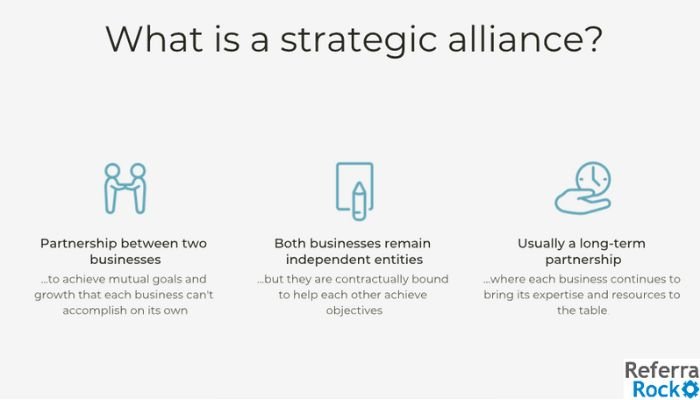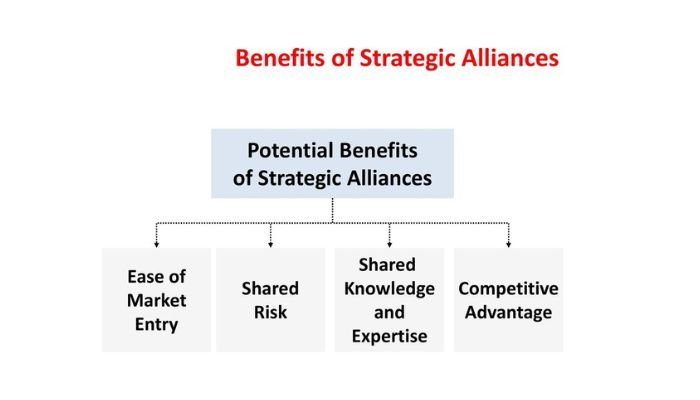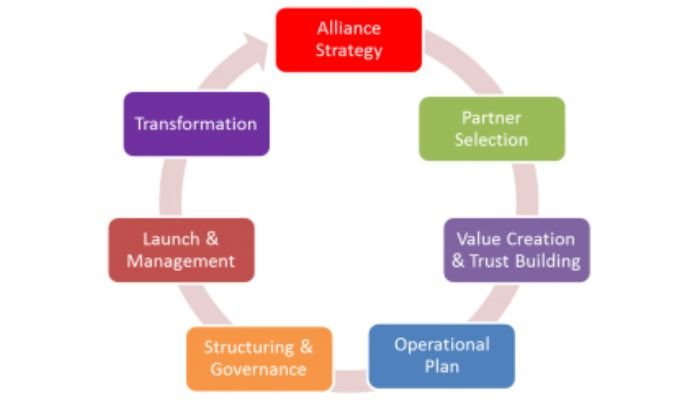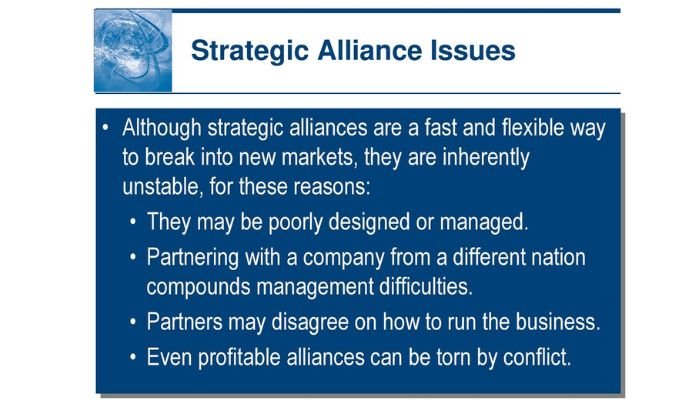Strategic Alliances: A Comprehensive Overview
Strategic alliances are formal relationships between two or more separate organizations usually entered into for mutual gain and increased competitive advantage.
Understanding when and how to use strategic alliances remains an important factor in businesses seeking the most value from these collaborative efforts.
The goal of this comprehensive overview is to examine the different types of strategic alliances, their overall benefits, effective formation and management, successful case studies as well as challenges that arise when forming partnerships.
Contents
When to Use Strategic Alliances

Identifying Business Needs and Objectives
Identifying business needs and objectives is often the first step in properly utilizing strategic alliances to improve profitability.
As any successful alliance requires effort and resources from both parties, start by keeping a comprehensive understanding of your organization’s places of strength, weaknesses, opportunities, and threats; for example consider whether weaker business areas could benefit from pooling resources with another partner’s strengths.
Organizations can use this initial evaluation to better target potential partners who match up accordingly, meeting communal objectives. Then reaching out and determining synergy between organizations will help mutually create achievable win-win goals together toward success through collaborative efforts over time.
Evaluating Market Opportunities and Challenges
Evaluating market opportunities and challenges is a critical step in determining when to use strategic alliances.
By assessing the competitive landscape, companies can identify where they are positioned and how they could leverage partnerships in order to create greater value propositions for their target markets.
Through SWOT analysis, industry/market research as well as collaborative efforts across teams from various departments.
Businesses can gain a full understanding of potential risks/threats that need to be addressed and capitalize on any advantages or gap areas that may present opportunities for growth or cost savings via a mutually beneficial alliance with another company.
Assessing Internal Resources and Capabilities
When focused on assessing internal resources and capabilities, it is key to gain an understanding of what skills already exist in the organization.
This will be an important temperature check of whether or not certain resources that are vital may still need to be outsourced. It also allows businesses to make decisions to organize talent more wisely.
Additionally, by analyzing all internal resources and roles a rule should determine who plays which role efficiently is formed so confusion can be avoided externally and internally.
If anyone person “duplicates” labor costs can become additive quickly without needed results towards growth or renovation goals created through the alliance endeavors you choose.
Determining the Need for Collaboration and Synergy
In deciding when to use strategic alliances, one must pay careful attention to determining the need for collaborative synergy.
Opportunities may exist where two or more businesses can mutually benefit from pooling resources toward a common strategy. Examples include co-branding opportunities, cross-promotion, or cost-sharing initiatives that create greater effectiveness than could be obtained by acting independently of each other.
It is important to then access and analyze those situations currently or services foreseeable in the future that will ultimately validate the potential of such collaboration and alliance; emphasizing technical capabilities, market channels, support services, customer relationships or even industry standards should be considered as well along with resource advantages before undertaking such arrangements.
Types of Strategic Alliances
Joint Ventures
A joint venture (JV) is a type of strategic alliance in which two or more independent business entities agree to collectively develop, cooperate on, and share the rewards of a specific business project.
As each party contributes resources – such as their customers, networks, financial assets, and competences– combined actions create new dimensions for mutual benefits; the JV shares ownership jurisdiction and profits/losses from capital investments amongst all involved. The scope may contain ways to reduce costs via resource sharing while extending reach through diversified networks and capabilities.
Integrating different elements of an organization can improve efficiency fueling both parties’ growth opportunities as they consider existing distributions across multiple possibilities simultaneously when it makes sense.
Equity Partnerships
Equity partnerships are a type of strategic alliance that involve the pooling of financial investments.
These partnerships allow companies to leverage each other’s investments and distribute financial resources among the partners for further business expansion or development, as well as combine their resources, knowledge, customers, and expert skillsets for mutual benefit.
Equity partnership agreements can vary hugely depending on the goals established by both parties. But typically mandate that all risks associated with the newly formed business venture are shared amongst both (or more) companies specified in the agreement in predetermined percentages.
Distribution Agreements
Distribution agreements are an important type of strategic alliance, primarily used when companies wish to use an intermediary to sell or distribute their products in markets they cannot access with their own resources.
Both parties generally will sign a contract in the agreement, outlining responsibilities and terms for distributing products. The sales may occur through direct or indirect distribution channels between the two partners in the trading arrangement.
Distribution alliances can be incredibly beneficial if both partner companies have interdependent strategies that forego unnecessary risks associated with common pitfalls encountered by most companies conducting new entry-level ventures into unknown territories.
Licensing and Technology Transfer
Licensing and technology transfers represent a type of strategic alliance whereby one organization licenses its intellectual property (including trademarks, copyrights, patents, or trade secrets) to another company for commercial usage.
The licensee pays royalties or fees in return and is generally able to access proprietary capabilities leveraged by the licensor’s resources.
Over time these alliances can add value due to the unrestricted access afforded to latest technologies and developments while bound limits govern how this information can be distributed for both parties’ benefit.
Such boundaries on production largely align goals between firms operating license/technology transfer agreements in joint long-term affinity that facilitates positive outcomes.
Research and Development Collaborations
Research and Development (R&D) collaborations constitute process-related strategic alliances that enable parties to pursue a shared mutual development goal.
This is the most cost-intensive form of resource commitment for organizations since they are required to invest in technology and Intellectual Property parts as a token of their commitment towards innovation.
Organizations can tap into several innovators’ skills which develop lucrative intangible assets culminating with research-based value propositions contributing greatly to their competitive advantages.
Benefits of Strategic Alliances

Access to New Markets and Customers
One of the most beneficial aspects of forming strategic alliances is gaining access to new markets and customers. Partnering with companies employing a different set of skills or resources makes it easier to target new audiences or geographies.
In addition, strategic alliances can provide access to qualitative products that would otherwise be difficult or impossible for individual companies to introduce on their own.
Alliances aren’t limited only to product offerings, as collaborative forces can also extend your reach through expanding brand visibility and greater overall penetration into untapped marketplaces.
Utilizing respected partners typically leads to increased credibility from potential consumers looking for suppliers that meet certain standards and utilize best practices when creating solutions already used by other dependable entities.
Sharing resources and minimizing costs are existing hidden benefits for strategic alliances.
Together, businesses can enhance their tools and services to build strength in the market with large collective access stocks or discounts on raw materials.
Utilization of shared infrastructure mechanisms cut important costs proving not only effective resource collaboration among different alliance organs but also cost synergies achieved between members’ markets perfecting pricing business performance altogether.
Leveraging Complementary Skills and Expertise
A key benefit of strategic partnerships is leveraging complementary skills and expertise. By forming strong, productive alliances with other companies, firms are able to access a host of resources and capabilities beyond those they have internally.
This often includes those vital to achieving desired outcomes such as technologies, expertise, production capacities, or distribution channels.
Companies may also capitalize on one another’s brand image which increases brand credibility in a mutually beneficial fashion. These new abilities bring greater depth and encourage organizational learning in order for mutual growth to end success.
Risk Mitigation and Increased Flexibility
Risk mitigation and increased flexibility are important benefits of strategic alliances for businesses.
Although risk cannot be eliminated entirely, allying with a partner can significantly reduce exposure to financial, political, technological or market risks by utilizing their complementary strengths and resources.
Strategic alliances also provide more strategic agility and ultimately increase the responsiveness necessary to adjust to new challenges.
Knowing when it is time to shift business objectives creates greater opportunity to be proactive as opposed to reactive in order for companies to succeed within very competitive global markets.
Enhanced Competitive Advantage
Strategic Alliances can greatly enhance a company’s competitive advantage by allowing for access to new skills, technology, innovation and other resources.
Companies are able to benefit from the strengths of their partners while expanding the pool of customers and potential earnings.
Sharing costs and resources also allows businesses to more effectively introduce products into new markets or industries with reduced start-up risks compared to sole investments.
Strategic alliances provide an invaluable combination of capabilities that facilitate accomplishing strategic objectives quickly and cost-effectively in highly competitive business environments.
How to Form and Manage Strategic Alliances

Identifying Potential Partners
Identifying potential partners is the first step in forming a strategic alliance.
To ensure success, it’s critical to find partners that are reputable with complementary objectives, resources, and capabilities—in other words, those partners that have something valuable to contribute to progress towards achieving collective goals.
Additionally, evaluation methods like SWOT analysis may be beneficial to better understand how particular allies can provide the most advantageous benefit for all parties involved.
Keep cultural preferences and environment in mind when researching possible collaborators as shared values play a large role in aligning partnership objectives effectively.
Negotiating and Structuring the Alliance
Negotiating and structuring strategic alliances involves collaborating to create a mutually beneficial agreement that meets the objectives of both parties.
Important steps include establishing aspirations, keeping focused on your ultimate goal or true North Star, contenting non-negotiable items in advance and aligning the overall objective between each respective party.
It’s also important the informal talks discussion define responsibilities as specified roles for each member in order to eliminate any future confusion. Additional considerations such as contingency plans relative to outcomes outside of predefined scope should also be kept in-mind when hammering out these agreements.
Establishing Clear Goals and Expectations
Open communication is key to successful alliances and therefore preventing disputes. Partners must take the time to create tangible, realistic short and long-term goals that all parties are in agreement to meet.
Alliances should carefully craft these expectations into a joint accord or contract with clear paths of progress toward the end outcome for each partner. Doing so serves as an important guiding tool along the journey of alliance building and collaboration.
Building Trust and Effective Communication
Building trust and effective communication are key ingredients to establishing and managing any kind of successful partnership.
It involves open collaboration and honest dialog among the partners about expectations for the partnership as well as engaging in continuous dialog of feedback and refinement each step along the way.
It also overcomes cultural differences by celebrating each partner’s unique way of working that together catalyzes mutually beneficial solutions for everyone embedded throughout all levels of the organization.
Monitoring Performance and Maintaining the Alliance
Strategic alliances exist to suit the changeable nature of today’s markets. Being able to consistently adapt and improve over time is key to obtaining lasting results. In order to maximize effectiveness, it must be closely monitored using metrics that are pertinent to collective and individual goals.
This should include their operational performance, ongoing capabilities, and customer satisfaction ratings which provide insight into the effectiveness or performance issues that need quickly addressed.
Stability in loyalty and communication amongst the strategic partners as well as powerful collaboration skills form crucial partnerships between all groups involved.
Infrequent assistance from outside coaching can greatly help difficult collaborations actualize new wins The ability to measure impact allows urgency as needed while discovering innovative growth trends ensures longevity over time.
Challenges and Risks of Strategic Alliances

Cultural and Organizational Differences
Cultural and organizational differences are a great challenge when it comes to forming strategic alliances. Different cultures have different work or communication styles that can clash in times of disagreement or stress.
Likewise, organizations may require more formality than another alliance partner needs in decisions roles, goals, relationships or agreements.
Before partnering with another organization for an alliance pursue better knowledge and understanding by researching each partner’s culture knowing their shared norms, values, assumption and perceptions as different people may regard the same situation differently.
Misalignment of Goals and Expectations
Misalignment of goals and expectations in a Strategic Alliance can arise when partners disagree over a motive or an interpretation of a negotiation outcome.
Partners in Strategic Alliances must be clearly defined regarding aim, ownership, communication, event planning, and financials to remain clear about parties’ involvement and obligations to each other.
Building effective and trustworthy relationships through excessive communication is the most successful strategy but misalignment may still arise without regular review and adaptation.
Information Sharing and Intellectual Property Concerns
Information sharing and intellectual property concerns are common challenges for strategic alliances. Partners must ensure that shared information is secure, with appropriate confidentiality often maintained via contract language.
Moreover, when insights and knowledge are developed in an alliance, such as through research and development projects, it’s important to clearly define ownership of any resulting innovations or Intellectual Property. Due diligence regarding properties controlled by the partners should be conducted at the onset of any collaboration and throughout their duration.
Conclusion
Strategic alliances can provide much-needed resources and enhanced competitive advantages, making them an advantageous business practice.
It is important to understand when and how to use these collaborations for maximum benefit; some strategies include having realistic goals and expectations, building trust with open communication, and adapting flexibly when needed.
Armed with the right knowledge of potential implications and strong relationship management practices, companies have larger opportunities through strategic alliances – while minimizing risks – allowing them stronger competitiveness in a persistently expanding market.

Ryan Nead is a Managing Director of InvestNet, LLC and it’s affiliate site Acquisition.net. Ryan provides strategic insight to the team and works together with both business buyers and sellers to work toward amicable deal outcomes. Ryan resides in Texas with his wife and three children.